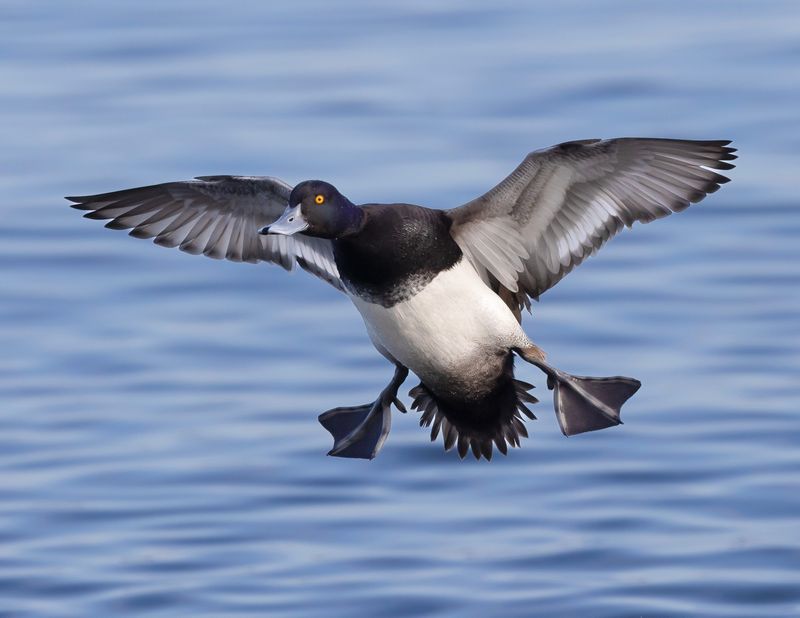I awoke the morning of Nov. 10 to our first real taste of winter. A blanket of snow covered the ground, and temperatures were in the mid-20s. Sayonara to the last of the wildflowers, butterflies and moths, and singing insects such as crickets and katydids. Most migrant songbirds such as thrushes, vireos and warblers are already long gone.
While the next three or four months will largely seem dormant, winter brings hardy visitors for which Ohio represents a Floridian vacation. Prominent among the ranks of our wintering birds are the waterfowl. Forty-three species of ducks, geese and swans have been recorded in Ohio — the most species of any bird family in Ohio.

As long as open water is available, ducks and their allies can be found. Central Ohio reservoirs such as Alum Creek, Hoover and Deer Creek attract scads of fowl. The ubiquitous and year-round Canada geese and mallards are augmented by species that breed to our north, such as the lesser scaup in the accompanying photograph.
Ducks fall into two major categories: dabblers and divers. Dabblers, like the mallard, favor shallow water and tip up to grub plants and aquatic animals from the bottom. A dozen species of dabblers have occurred in the state, and nine of them are common, at least seasonally.
Diving ducks prefer deeper waters and can make deep dives to capture aquatic prey. Twenty species have appeared in the state, and 11 of them are common, especially in winter.
Lake Erie, the most biologically rich of the five Great Lakes, greatly influences the waterfowl that appears in Ohio. A subdivision of the diving ducks is the “sea ducks” species that primarily spend winters on salt water. Lake Erie is an inland sea, and fowl that are rare inland, such as long-tailed duck and three species of scoters, appear on our great lake in numbers in winter.
Black, surf and white-winged scoters, and the long-tailed duck, nest in the arctic. Frigid conditions on wintertime Lake Erie are nothing to these hardy birds, nor is the depth of the lake. Long-tailed ducks can dive to depths of 200 feet, and scoters routinely dive to 40 feet or more. As Lake Erie’s average depth is only 62 feet, it is like a puddle to these birds.
Another subdivision of diving ducks is the “bay ducks.” Their ranks include the canvasback, greater and lesser scaup, redhead and ring-necked ducks. They prefer shallower waters and generally don’t dive as deep as sea ducks. Large flocks of bay ducks can occur on local lakes.
The lesser scaup is one of the most abundant diving ducks in Ohio in migration and winter. Massive flocks can form on reservoirs. The largest concentrations occur in the shallow waters of Lake Erie’s Maumee Bay, near Toledo. Their numbers peak in late winter, when up to 80,000 scaup have been tallied.
Yet another subset of diving ducks are the mergansers, or “sawbills.” Three species pass through or breed in the state: common, hooded and red-breasted mergansers. Strongly serrated bills allow mergansers to seize and hold fish caught in underwater dives.
The most prominent wintering merganser is the red-breasted merganser. While it appears routinely on local lakes, sometimes in large numbers, Lake Erie hosts the greatest numbers. They peak in November and December, and I have watched flocks pass by near Huron that boggle the imagination. So prolific are the mergansers that the flocks look like low storm clouds scudding over the water. A quarter-million birds have been tallied at Huron and vicinity in an hour’s time.
Two personal favorite diving ducks are the closely related bufflehead and common goldeneye. The tiny black-and-white bufflehead is our smallest duck, weighing only a pound. They’re tough as nails and some overwinter, enduring even the harshest conditions.
Common goldeneyes are sometimes called “whistlers” as their wings emit a distinctive whistling hum in flight. Like most other diving ducks, goldeneyes seem impervious to cold wintry conditions. I have often marveled at their toughness when watching goldeneyes cavorting in water that is literally freezing before my eyes. I recall many times standing on bluffs overlooking Lake Erie at Avon Lake — one of the coldest spots in wintertime Ohio — watching goldeneyes do their thing in subzero temperatures with strong winds. To them, such conditions are nothing. This observer was indeed grateful to have a warm car to retreat to.
Goldeneyes are perhaps the first real harbinger of spring. Amorous males begin courting females In February, no matter how cold, snowy and icy it is. Several males will surround a seemingly disinterested hen and launch into their comical aquatic break dancing. The black-and-white drake throws his head back while simultaneously lunging forward and kicking his bright orange feet from the water. All the while he issues loud squeaking buzzes, and courting group creates quite the buzz-fest.
A good local spot for immersion into wintertime waterfowl is Blendon Woods Metro Park and its 11-acre Walden Pond. Blinds make for easy viewing and aerators in the lake create open water even during the coldest snaps.
Naturalist Jim McCormac writes a column for The Dispatch on the first, third and fifth Sundays of the month. He also writes about nature at www.jimmccormac.blogspot.com.
This article originally appeared on The Columbus Dispatch: Hardy waterfowl swoop into Ohio as most migrant songbirds head south
Reporting by Jim McCormac / The Columbus Dispatch
USA TODAY Network via Reuters Connect



